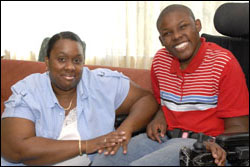Duchenne/Becker Muscular Dystrophy
 The most common form of muscular dystrophy in children is Duchenne muscular dystrophy (DMD). Learn more about this genetic disorder that affects about 1 out of every 3,500 to 6,000 boys.
The most common form of muscular dystrophy in children is Duchenne muscular dystrophy (DMD). Learn more about this genetic disorder that affects about 1 out of every 3,500 to 6,000 boys.
Duchenne muscular dystrophy (DMD) is the most common form of muscular dystrophy in children. DMD is most often diagnosed when a child is 3 to 6 years of age. Early signs include delay in walking, frequent falling, and difficulty getting up from a sitting or lying position. Muscles become weaker over time and children who have DMD usually become unable to walk by age 12. The disease is usually fatal in the teens or early 20s, most commonly due to severe breathing or heart problems, or both.
A milder form of the disease is known as Becker muscular dystrophy (BMD). Together, the two forms of the disease are referred to as Duchenne/Becker muscular dystrophy (DBMD). There are a few treatments that can help slow down the weakening of the muscles, such as the use of steroids, but there is currently no cure for DBMD.
What Causes DBMD?
Duchenne/Becker muscular dystrophy is a genetic disorder. In 1986, researchers found the gene that, when flawed (a problem known as a mutation), causes DBMD. When there is a flaw or mutation in this gene, the body can not make a working version of a muscle protein called dystrophin. Individuals who have DBMD have low levels or abnormal dystrophin in their muscles. Without dystrophin, their muscles are not able to work properly and become weaker over time.
Learn more about the cause of DBMD.
Learn more about genes and mutations.
Who Has Duchenne/Becker Muscular Dystrophy?

DBMD affects approximately 1 out of every 3,500 to 6,000 boys. With over 4 million births in the United States each year, about 400 to 600 boys with DBMD are born every year. Girls rarely have DBMD.
About one-third of the time, someone else in the family has DBMD, such as a brother, uncle, or cousin. But the other two-thirds of the time, the boy is the first one in the family to have DBMD. There are no known risk factors for these cases, so a boy with DBMD can be born into any family at any time.
Likewise, a girl who is a carrier of DBMD (a female who has one copy of the DBMD mutation and therefore can pass it on to her sons) can be born into any family at any time. Later in life, carrier females sometimes develop heart problems and may have shortness of breath or may not be able to do moderate exercise. The chance that a carrier female will develop heart problems is unknown. These heart problems, if untreated, can be serious and life threatening.
What Is CDC Doing About DBMD?
In 2001, through the Muscular Dystrophy Community Assistance Research and Education Amendments of 2001 or the MD-CARE Act, Congress authorized CDC to develop public health programs related to muscular dystrophy. In response to this Act, the Single Gene Disorders and Disability (SGDD) program at CDC, along with key stakeholders in the muscular dystrophy community, has launched programs that focus on developing a DBMD tracking system, improving screening and diagnosis of DBMD, and improving services for people who have DBMD and their families.
More Information
Duchenne/Becker Muscular Dystrophy
Screening and Diagnosis for DBMD
Services for People Who Have DBMD and Their Families
![]() Muscular Dystrophy Surveillance Tracking and Research Network (MD STARnet)
Muscular Dystrophy Surveillance Tracking and Research Network (MD STARnet)
Current Features
Need info on a
different topic? See



